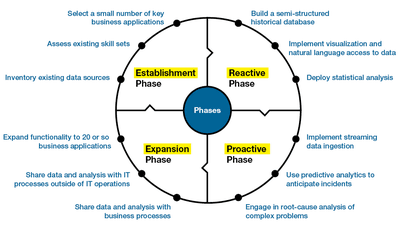The developer of Claude has released the results of a survey on the uses of chat AI, with more people using it for computer and education-related purposes

Anthropic, the AI development company behind the chat AI Claude, has launched the
Last month we launched our Anthropic Economic Index, to help track the effect of AI on labor markets and the economy.
— Anthropic (@AnthropicAI) March 27, 2025
Today, we're the second research report from the releasing Index, and sharing several more datasets based on anonymized Claude usage data. pic.twitter.com/2difF90Zlq
Anthropic Economic Index: Insights from Claude 3.7 Sonnet \ Anthropic
https://www.anthropic.com/news/anthropic-economic-index-insights-from-claude-sonnet-3-7
Anthropic launched the Anthropic Economic Index in February 2025 and released its first report on the use of AI. It has since released a new model, Claude 3.7 Sonnet , that provides both 'real-time answers' that immediately answer questions and 'thoughtful answers' that use more reasoning.
On March 28th local time, Anthropic released the second research report of the Anthropic Economic Index, covering usage after the release of Claude 3.7 Sonnet. The analysis was conducted using Clio , a tool that automatically analyzes conversations with Claude while protecting user privacy, and covers 1 million anonymized conversations. The majority of the data analyzed was from Claude 3.7 Sonnet, which is set as the default for both the web version and mobile app of Claude.
Clio maps the conversation between the user and the AI to one of 17,000 tasks from the U.S. Department of Labor's occupational information database ' O*NET ,' and can see patterns in jobs related to that task and broader job categories. The graph below shows the percentage of job categories among Cluade users, with the first report released in February shown in gray, those that increased in the second report shown in green, and those that decreased in blue. It can be seen that the percentage of use in fields such as coding, education, and science, such as 'Computer and Mathematical,' 'Education Instruction and Library,' and 'Life, Physical, and Social Science,' is increasing.
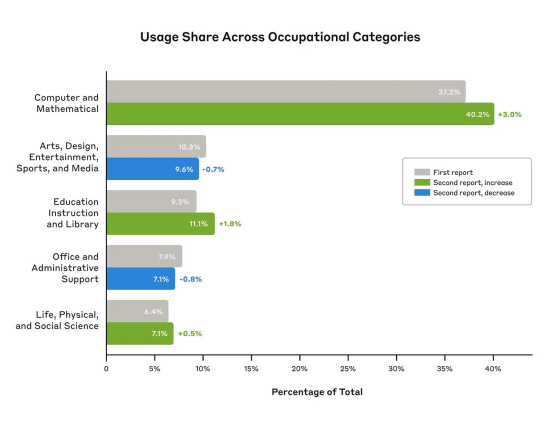
The following is a table showing the percentage of users who used 'extended thinking,' which provides a well-thought-out answer, by category. The most common was 'Computer & Information Research Scientists' at 9.7%, followed by 'Software Developers, Applications' at 8.4% and 'Software Developers, Systems software' at 8%. In addition, 'Multimedia Artists & Animators' at 6.9% and 'Video Game Designers' at 6.2%, were also frequently used for tasks related to digital creativity. Please note that these categories are based solely on conversation classifications and do not indicate what occupations the actual users have.
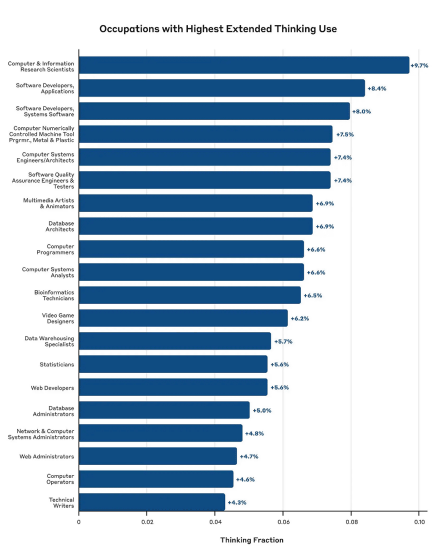
Anthropic categorizes AI usage into 'augmentative' use, such as learning and repetition, and 'automatic' use, where the model is used to complete tasks directly. The ratio of augmentative to automated use did not change between the first report and this one, with augmentative use accounting for 57% of the total. However, the detailed breakdown was different.
The graph below shows the breakdown of augmentative use at the top and automated use at the bottom. Looking at augmentative use, we can see that tasks related to 'Iteration,' which was 31.3% in the first report, decreased to 24.8% in the second, and tasks related to 'Learning,' instead, increased from 23.3% to 28%.
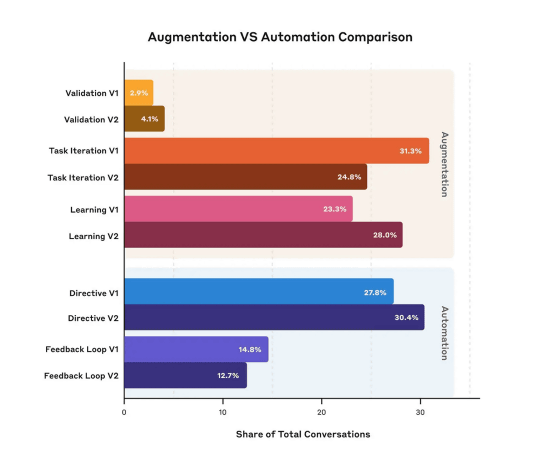
The graph below shows the augmented use (brown, orange, pink) and automated use (navy blue, blue) by occupational category. While augmented use accounts for nearly 75% in 'Healthcare Practitioners and Technical' and 'Community and Social Service,' which includes the education sector, automated use accounts for nearly 50% in 'Arts, Design, Ent., Sports, and Media' and 'Computer and Mathematical.'
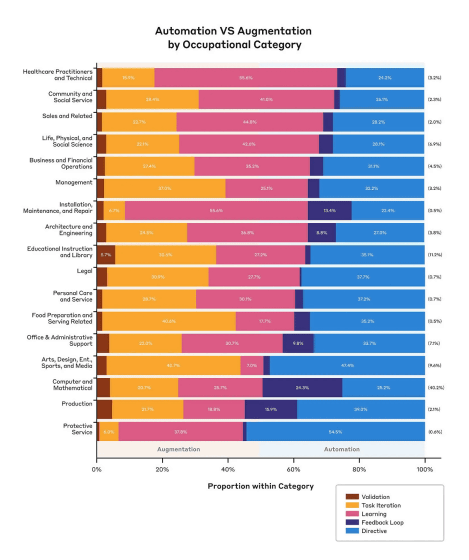
In addition, previous analyses have relied on the O*NET database, but modern AI is also used for tasks that do not exist in O*NET, so there may be tasks that are overlooked in the analysis. Therefore, Anthropic plans to release a bottom-up dataset that classifies tasks that users use AI for into 630 detailed clusters based on user activity. Analysis of the dataset is a future task, but the following tasks are particularly interesting:
・Supporting water management systems and infrastructure projects
- Creating physically based simulations with interactive visualization
- Assistance with font selection, implementation and troubleshooting
- Creating or improving job application materials
- Providing guidance on battery technology and charging systems
Assistance with time zone handling in code and databases
Anthropic has published a series of detailed data on its AI platform, Hugging Face.
Anthropic/EconomicIndex · Datasets at Hugging Face
https://huggingface.co/datasets/Anthropic/EconomicIndex
Related Posts:
in Software, Web Service, Posted by log1h_ik


